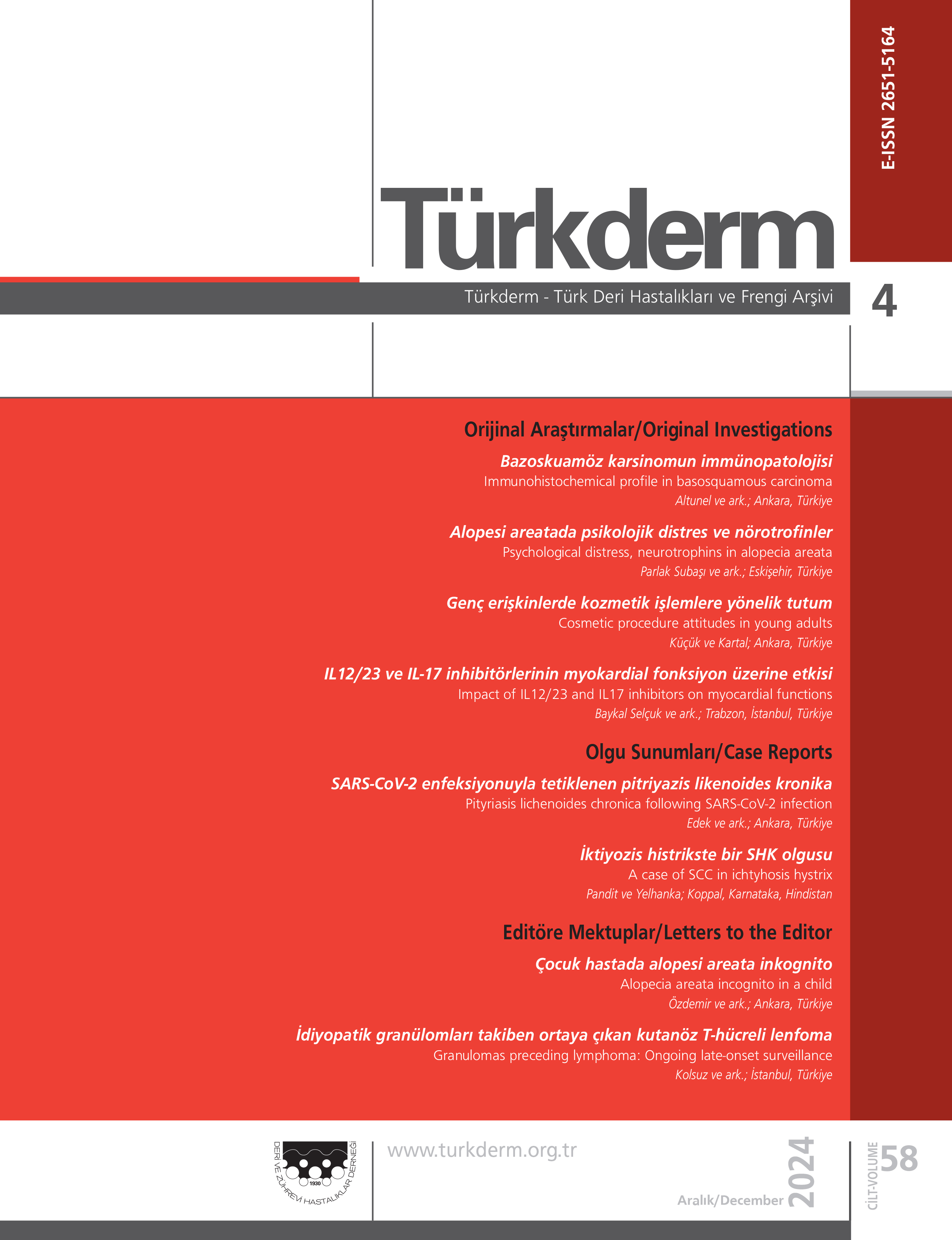




















Dergimiz 2012 aralık sayısıyla karekod sistemi uygulamasına başlamıştır.
Makalelerin üzerinde bulunan Karekodu dilediğiniz akıllı cihazınız ile okutarak makaleyi indirebilir veya meslektaşlarınızlada paylaşa bilirsiniz.
Cihazınıza QR codeReader app indirerek uygulamayı kullanmaya başlayabilirsiniz.
Apple app için tıklayınız
Android app için tıklayınız
Erizipel ve Tinea Pedis
Kıymet Baz, Ayça Cordan Yazıcı, Dilek Üstünsoy, Güliz İkizoğluMersin Üniversitesi Tıp Fakültesi Deri ve Zührevi Hastalıklar Anabilim DalıErizipel genellikle A grubu streptokokların neden olduğu, derinin akut yüzeyel bir infeksiyonudur. Hastalığın klasik yerleşim yeri olan yüzde görülme sıklığı azalırken, alt ekstremitelerde görülme sıklığı artmaktadır. Hastalık için alt ekstremitelerde dolaşım bozukluğu, immünyetmezlik, diabetes mellitus ve tinea pedis gibi çeşitli kolaylaştırıcı faktörler bildirilmiş olmakla birlikte, tinea pedisin rolünün irdelendiği az sayıda çalışma mevcuttur. Bu çalışmada bir grup erizipelli hastada predispozan faktörlerin belirlenmesi ve özellikle tinea pedis ile erizipel arası ilişkinin değerlendirilmesi amaçlanmıştır. Bu amaçla 21 kadın, 23 erkek toplam 44 erizipelli hasta klinik ve epidemiyolojik özellikleri açısından değerlendirilmiştir. Erizipel lokalizasyonu 32 hastada alt ekstremite, 6 hastada yüz, 5 hastada üst ekstremite, 1 hastada ise gövde idi. Alt ekstremitede erizipeli olan 32 hastanın 20sinde (%62,5) tinea pedis tespit edilirken bunlardan 14ünde (%70) tinea pedis tek predispozan faktör iken kalan 6 hastada venöz yetmezlik, diyabet, alkol ya da nikotin bağımlılığı gibi başka bir predispozan faktörün de eşlik ettiği tespit edildi. Sonuç olarak erizipel için alt ekstremite en sık yerleşim yeri, tinea pedis ise en sık predispozan faktör olarak tespit edilmiştir. Dolayısıyla tinea pedis, özellikle sık görüldüğü sıcak iklimlerde, erizipel için bir risk faktörü olabilir. Halk sağlığı açısından tinea pedisin tespit ve tedavisi erizipelin önlenmesinde önemlidir.
Anahtar Kelimeler: Erizipel, tinea pedisErysipelas and tinea pedis
Kıymet Baz, Ayça Cordan Yazıcı, Dilek Üstünsoy, Güliz İkizoğluMersin Üniversitesi Tıp Fakültesi Dermatoloji Anabilim DalıBackground and Design: Erysipelas is an acute, superficial infection of the skin, generally caused by group A streptococci. The epidemiology has changed, with an increase of the number of erysipelas of the lower leg whereas face localization is less frequent. Several predisposing factors have been described for the disease such as circulatory insufficiency of the legs, diabetes mellitus, immunsupression, and tinea pedis, but there are only a few studies focused on the role of tinea pedis as a predisposing factor. The aim of this study was to establish clinical characteristics and predisposing factors for erysipelas and particularly how tinea pedis and erysipelas are related to this condition. MATERIAL-METHOD: Forthy-four clinically well-defined cases of erysipelas were included in this study. All patients were analysed for clinical and epidemiological findings. RESULTS: The cases comprised 21 women and 23 men. Of the 44 patients, 32 had erysipelas of the lower legs, whereas 6, 5 and 1 had lesions of the face, upper limb and trunk, respectively. Out of 32 patients with erysipelas localized on lower legs, 20 (%62,5) had tinea pedis. Of these 20 patients, 14 (%70) had only tinea pedis as a predisposing factor and the rest had more than one predisposing factor such as venous deficiency (n=1) on the lower legs, diabetes mellitus (n=3), alcoholism (n=2), and nicotine abuse (n=4). CONCLUSION: The lower legs were the most frequently involved areas for erysipelas, and tinea pedis was identified as the major predisposing factor for erysipelas. Tinea pedis is a risk factor for erysipelas, mainly in tropical countries as ours where its prevelance is high. From a public health perspective, detecting and treating tinea pedis should be evaluated in the secondary prevention of erysipelas of the leg.
Keywords: Erysipelas, tinea pedisMakale Dili: Türkçe




